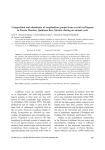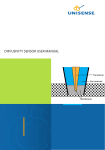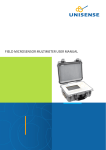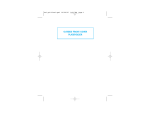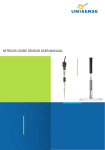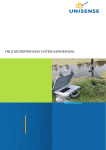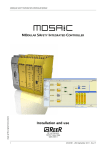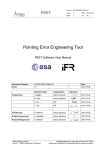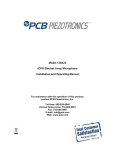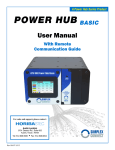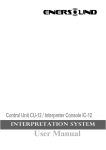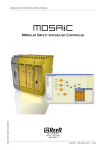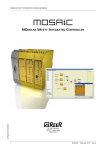Download HYDROGEN SULFIDE SENSOR USER MANUAL
Transcript
HYDROGEN SULFIDE SENSOR USER MANUAL 1 Hydrogen sulfide sensor manual Copyright © 2012 · Unisense A/S Version October 2012 HYDROGEN SULFIDE SENSOR MANUAL UNISENSE A/S TABLE OF CONTENTS WARRANTY AND LIABILITY . . . . . . . . . . . . . . . . . . . . . . . . . . . . . . . . . . . . . . . . . . . . . . . . . . . 6 CONGRATULATIONS WITH YOUR NEW PRODUCT! . . . . . . . . . . . . . . . . . . . . . . . . . . . . 7 Support, ordering, and contact information 7 OVERVIEW . . . . . . . . . . . . . . . . . . . . . . . . . . . . . . . . . . . . . . . . . . . . . . . . . . . . . . . . . . . . . . . . . . . . 9 GETTING STARTED . . . . . . . . . . . . . . . . . . . . . . . . . . . . . . . . . . . . . . . . . . . . . . . . . . . . . . . . . . 11 Unpacking a new sensor Polarize picoammeter Connecting the microsensor Pre-polarization Calibration 11 11 11 11 12 Calibration theory 12 Calibration in the laboratory 14 Calibration in the field 16 Re-calibration17 MEASUREMENTS . . . . . . . . . . . . . . . . . . . . . . . . . . . . . . . . . . . . . . . . . . . . . . . . . . . . . . . . . . . . 18 Mounting the sensors Electrical noise pH influence Interference 18 18 18 19 ADVANCED USE . . . . . . . . . . . . . . . . . . . . . . . . . . . . . . . . . . . . . . . . . . . . . . . . . . . . . . . . . . . . 20 STORAGE AND MAINTENANCE . . . . . . . . . . . . . . . . . . . . . . . . . . . . . . . . . . . . . . . . . . . . . . 21 Cleaning the sensor 21 REFERENCES . . . . . . . . . . . . . . . . . . . . . . . . . . . . . . . . . . . . . . . . . . . . . . . . . . . . . . . . . . . . . . . . 22 TROUBLE SHOOTING . . . . . . . . . . . . . . . . . . . . . . . . . . . . . . . . . . . . . . . . . . . . . . . . . . . . . . . 23 WARRANTY AND LIABILITY Notice to Purchaser This product is for research use only. Not for use in human diagnostic or therapeutic procedures. Warning Microsensors have very pointed tips and must be handled with care to avoid personal injury and only by trained personnel. Unisense A/S recommends users to attend instruction courses to ensure proper use of the products. Warranty and Liability The hydrogen sulfide microsensor is covered by a 90 days limited warranty. Microsensors are a consumable. Unisense will only replace dysfunctional sensors if they have been tested according with the instructions in the manual within 14 days of receipt of the sensor(s). The warranty does not include repair or replacement necessitated by accident, neglect, misuse, unauthorized repair, or modification of the product. In no event will Unisense A/S be liable for any direct, indirect, consequential or incidental damages, including lost profits, or for any claim by any third party, arising out of the use, the results of use, or the inability to use this product. Unisense mechanical and electronic laboratory instruments must only be used under normal laboratory conditions in a dry and clean environment. Unisense assumes no liability for damages on laboratory instruments due to unintended field use or exposure to dust, humidity or corrosive environments. Repair or Adjustment Sensors and electrodes cannot be repaired. Equipment that is not covered by the warranty will, if possible, be repaired by Unisense A/S with appropriate charges paid by the customer. In case of return of equipment please contact us for return authorization. For further information please see the document General Terms of Sale and Delivery of Unisense A/S as well as the manuals for the respective products. 6 CONGRATULATIONS WITH YOUR NEW PRODUCT! Support, ordering, and contact information The Unisense hydrogen sulfide microsensor is a miniaturized Clark-type hydrogen sulfide sensor designed for reliable and fast measurements in a large number of research applications. If you wish to order additional products or if you encounter any problems and need scientific/technical assistance, please do not hesitate to contact our sales and support team. We will respond to your inquiry within one working day. E-mail: [email protected] Unisense A/S Tueager 1 DK-8200 Aarhus N, Denmark Tel: +45 8944 9500 Fax: +45 8944 9549 Further documentation and support is available at our website www.unisense.com. REPLACEMENT OF SENSORS Unisense will replace sensors that have been damaged during shipment provided that: • The sensors were tested immediately upon receipt in accordance with the delivery note and the manual • The seal is still intact. • The sensors are returned to Unisense for inspection within two weeks. • The sensors are correctly packed for return to Unisense, in accordance with the note included in the sensor box. 7 RECOMMENDED AMPLIFIERS One-channel amplifier: Microsensor Monometer Multi-channel amplifiers: Microsensor Multimeter 8 OVERVIEW This manual covers all the Unisense hydrogen sulfide sensors. IMPORTANT Unisense sensors are neither intended nor approved for use of humans The Unisense H2S microsensor is a miniaturized amperometric sensor with a guard electrode. The microsensor is designed for research applications within physiology, biotechnology, environmental sciences, and related areas. With its minute tip size, excellent response time, and minimal stirring sensitivity, the Unisense H2S sensor makes it possible to make reliable and fast measurements at high spatial resolution. LEMO plug The LEMO connector contains connections for both reference, guard, and sensing cathode. Sensor tip For calculation of total sulfide concentrations, it is necessary to know the pH. When measuring H2S in pH gradients, pH should be measured along the same profile with a pH microsensor (e.g. Unisense PH10/PH25). Cable includes guard The Unisense H2S microsensor is a miniaturized amperometric sensor with an internal reference, a sensing and a guard anode. The sensor is connected to a high-sensitivity picoammeter and the anodes are polarized against the internal reference. Driven by the external partial pressure, H2S from the environment will penetrate through the sensor tip membrane into the alkaline electrolyte, where the HS- ions formed are oxidized immediately by ferricyanide, producing sulfur and ferrocyanide. The sensor signal is generated by re-oxidation of ferrocyanide at the anode in the tip of the sensor (Jeroschewski et al. 1996). The Unisense picoampere amplifier converts the resulting reduction current to a voltage signal. Also the internal guard electrode is polarized to scavenge H2S and helps keeping a constant ratio of ferri- to ferro cyanide in the electrolyte, thus minimizing zero-current. 9 The electrolyte in the H2S microsensor is photo-degraded by high light intensities – especially UV and blue light. This is seen as a higher signal in light as compared to the signal in darkness for the same amount of H2S. The sensors are painted black to protect them against light. Light may however, still enter the sensor through the tip, which it is not possible to paint. 10 GETTING STARTED Unpacking a new sensor When receiving a new microsensor remove the shock-absorbing grey plastic net. Please do not remove the seal and protective tube before the following steps are successfully completed. NOTE: if you have a H2S-MR electrode, calibrate in the protective tube and then carefully move the sensor from this tube into the provided blue guide. Polarize picoammeter The signal from the H2S sensor is generated in pA. Therefore the H2S sensor must be connected to a Unisense picoampere amplifier during measurements. H2S sensors should be polarised with +85mV (on legacy PA2000 meters value is set at +0.08V). On the Microsensor Multimeter and Microsensor Monometer, sulfide sensors with lemo-connectors are automatically recognized and polarization automatically set. If you are using another amplifier or sensor connection type, please check the polarization voltage before connecting a sensor, since incorrect polarization may destroy the sensor. For details on how to set the polarization, consult the user manual of the amplifier that you are using. Connecting the microsensor Connect the LEMO connector to the input terminal. The LEMO connector contains connections for both reference, guard and sensing anode. Pre-polarization When the sensor is not in use, hydrogen sulfide will build up inside the electrolyte. This must be removed by the sensing anode and the guard anode before stable operation of the sensor is possible. WARNING Do not remove the seal and protective plastic tube before the following steps (1-4) and calibration are succesfully completed. IMPORTANT If you have a H2S-MR electrode, calibrate in the protective tube and then carefully move the sensor from this tube into the provided blue guide. PREPOLARIZATION If the sensor is new or has not been operated for several days, then it must be polarized for at least 2 hours before it can be calibrated and used. After shorter periods without polarization, the sensor should be polarized until it has exhibited a stable signal for 10 minutes. 11 Therefore, a period of polarization is necessary before you can use the sensor. This is called the pre-polarization period. If the sensor is new or has not been operated for several days, it must be pre-polarized for at least 2 hours before it can be calibrated and used. After shorter periods without polarization, the sensor should be pre-polarized until it has shown a stable signal for at least ten minutes. When pre-polarization is initiated, the signal will be very high and then drop rapidly over the first few minutes. After that, the signal will drop slowly for up to two hours (for needle- and some custom made sensors slightly longer). It takes normally between 10 minutes and an hour before a sensor is stable. The sensor signal depends on the specific sensor (see the delivery note which came with the sensor). If the signal does not stabilize or is too high or too low, refer to the ‘Troubleshooting’ section. Calibration Calibration theory The sensor detects the partial pressure of H2S gas, which is only one component of the total sulfide equilibrium system. If the total sulfide concentration, [S-2tot], is defined as: Stot-2 = [H2S] + [HS-] + [S2-] the H2S concentration will be defined as K1 ( [H2S] = [Stot-2] / 1 + + K1K2 [H30+]2 [H30+] ) [H3O+] = [H+] = 10-pH which can be simplified to ( [H2S] = [Stot-2] / 1 + K1 [H30+] ) for pH<9 (Jeroschewski et al. 1996). Thus it is necessary to know the pH (i.e. to know [H3O+]) of the sample/calibration solution to calculate [Stot-2] (see Figure 1). 12 IMPORTANT Calibration must be performed after pre-polarization when the sensor signal has stabilized. Always use a calibration solution with the same temperature and salinity as the sample solution. pH = -log [H+] In solutions with a pH below 4 the equation can be simplified to: [H2S] ≈ [Stot-2] K1 = 10-pK1 pK1 is dependent on temperature and salinity. The literature gives slightly different equations for calculating pK1 in water as a function of temperature (T) and salinity (S). The following equation is derived by Millero et al. 1988: pK1 = -98.08 + 5765.4/T + 15.04555 * LN(T) + (-0.157 * (S0.5)) + 0.0135 * S (Temperature in Kelvin) Figure 1. The species distribution of H2S, HS and S2- as a function of pH. As H2S sensors are sensitive to temperature, it is necessary to perform calibration and measurements at the same temperature. 13 Please note that, in contrast to oxygen, the relationship between salinity, temperature and solubility is not well known and therefore not tabled for sulfide gas Calibration in the laboratory Calibration must be performed after the sensor signal has stabilized during pre-polarization. The H2S microsensor responds linearly over a certain range (e.g. 0-300 µM), above which the slope of the response curve decreases, but the response and resolution above the linear range may be sufficiently good for reliable measurements. We suggest that you establish the linear range by making a coarse calibration in the entire concentration range of interest. If measurements of concentrations above the linear range are needed, a calibration with sufficient resolution has to be made in the non-linear range, whilst a 3-point calibration is sufficient in the linear range. Please read the entire procedure below before the calibration is commenced. It is best to first prepare the stock solution so it is ready. Then prepare the buffer and perform the calibration quickly thereafter in order to avoid reintroduction of oxygen. IMPORTANT It is important to perform calibration and subsequent measurements in solution with the same temperature and salinity. FIELD CALIBRATION For field calibrations, please see alternative calibration procedure below. NOTE: for field calibrations, an alternative method is recommended - this will enable you to prepare reagents to bring into the field for easy calibration. Laboratory calibration 1. Prepare a stock solution A stock solution of S2- (≈ 0,01M total sulphide) is prepared anaerobically by dissolving 0,24 g Na2S * 9 H2O in 100mL of N2-flushed water in a closed container. The final concentration of the stock solution should be determined by standard analysis (e.g. Cline 1969 or Budd & Bewick 1952). Keep the stock solution out of contact with oxygen. 2. Prepare the calibration buffer Any standard pH buffer, with a pH value less than 4, can be used. Remove oxygen from a volume of the buffer. This can be done in 14 WARNING Vigorous bubbling water with any gas may cause the water to cool considerably. Monitor the temperature to find a suitable bubbling rate, which does not cool the water significantly. two ways: a. By vigorously bubbling with an oxygen-free inert gas (e.g. N2) for at least 5 minutes. NOTE: Vigorously bubbling buffer with any gas may cause the water to cool considerably. Monitor the temperature to find a suitable bubbling rate, which does not cool the WARNING It may be difficult to use a standard analysis for sulfide in your calibration solution (e.g. Cline 1969) when a reductant has been added. buffer significantly. b. By adding a suitable reductant (e.g. Ti(III)Cl; MERCK supplies this in a 10% HCl solution) to the oxygen free buffer to a final concentration of 50 mM. Add a few glass beads (2-3 mm in diameter) to facilitate mixing. The transfer is preferably performed with a pipette to minimize mixing with oxygen, and a maximum of 10% of the vial volume should be left as headspace. Close the container with a gas tight lid and shake vigorously. 3. Obtain zero reading The signal at zero H2S can be obtained by immersing the sensor tip into one of the vials with calibration buffer. Note the signal, which is the calibration value for zero H2S partial pressure (S0). This signal should be 0-30 pA (otherwise see “Troubleshooting”). 4. Obtain sulfide standard readings Calibration points within the expected range of measurement are prepared by injecting suitable amounts of the S2- stock solution anaerobically into the calibration buffer with a micro-syringe (the stock solution should be diluted at least 10 times). Mix the solutions. If you have not added reductant, oxygen that dissolve in the calibration solution will oxidize the sulfide, so the stock solution should be added immediately after the oxygen removal (e.g. N2 bubbling) and the calibration should be done immediately after adding the stock solution. 15 For each calibration solution, measure the calibration values by removing the rubber stopper and immerse the microsensor tip into the solution. Read the signal and plot it against the concentration. The most precise calibration curve is obtained by fixing the calibration solutions with Zn-acetate and subsequently determining the total sulfide concentration using the Cline method (Cline 1969). This may, due to the nature of the method, be difficult if a reductant has been added previously. Calibration in the field For an easy and portable field calibration, prepare the following reagents in the lab. Bring the reagents and a 1 ml syringe+needle to the field. Reagent 1: • 1mM Na2S • 1mM NaOH Prepare the solution in a membrane flask with gas-tight lid. After mixing, flush the solution with nitrogen gas to remove all oxygen and quickly place the lid on the flask. During storage, practically all sulfide in Reagent 1 will be in alkaline form and since it is stored in an gas-tight vial, it cannot evaporate to any significant degree. Reagent 2: • 0.1 M HCl • 50mM TiCl As the TICl is a strong reducing agent, all oxygen will be reduced in the mixture, but it is still recommended that you avoid introducing too much oxygen during mixing. Fill reagent 2 into a 10 ml glass vial with gas-tight membrane lid. Avoid head space. Prepare as many vials as the number of calibrations you expect to make. Bring reagent 1, the vials with reagent 2 and 1 ml syringe+needle with you to the field. 16 Calibration in the field. Perform the zero point determination in clean water (without H2S) at field site temperature. Prepare a 100 µM calibration standard. Perform the calibration quickly after mixing as the durability of the mix is short. 1. Loosen the lid of a reagent 2 vial and remove carefully 1 ml with a syringe+needle through the lid. Throw this away. 2. Take 1ml of reagent 1 and add it to the reagent 2 vial. 3. Tighten the lid and mix. 4. Remove the lid and place the sensor tip carefully in the vial and perform the 100 mM calibration. For making higher or lower concentrated H2S calibration solutions, make reagent 1 more or less concentrated with Na2S. Re-calibration Check the calibration at appropriate time intervals and repeat it, if the sensor exhibits significant drift. When the sensor is new, you may need to calibrate it every two hours. An older extensively used sensor may require calibration only every 24 hours or less. To minimize the need for calibration, keep the sensor polarized between measurements if possible (unless the time between measurements exceeds several days). If the signal does not stabilize or remains too high or too low, refer to the “Troubleshooting” section in this manual. The response of the H2S microsensor does change with time, and a decrease in signal of up to 50% pr. month is to be expected. This does not affect the quality of the measurements as long as the sensor is regularly calibrated. 17 MEASUREMENTS Mounting the sensors Due to the small size of the microsensor tip and the steepness of H2S gradients in many environments, even a few microns’ displacement of the sensor tip may change its immediate H2S environment. The sensor tip is quite flexible and can bend around physical obstacles. But coarse lateral movements of the sensor when its tip is in contact with a solid substrate may easily cause the tip to break. Therefore measurements should be performed only in a stabilized set-up fixed on a sturdy table free of moving or vibrating devices. We recommend the Unisense lab stand LS18 and the Unisense micromanipulator MM-33 (MM33-2 or MMS) for this purpose. Electrical noise The signal of the microsensor is very small (10 -10 to 10-13 ampere). Although both the Unisense picoammeters and the Unisense H2S microsensors are very resistant to electrical noise from the environment, electrical fields may interfere with the sensor signal. Therefore we recommend that unnecessary electrical/mechanical equipment is switched off and by the sensor or wires are not touched during measurements and signal recording. On suspicion of sensor damage, repeat calibration and consult “Troubleshooting”. pH influence As mentioned above, the H2S concentration is a function of pH. If measurements of H2S are performed in points along a pH gradient, pH should be measured in the same points with a pH microsensor (e.g. Unisense PH10/PH25/PH100) to allow the determination of the total sulfide concentration. Use the equations in the calibration section in order to calculate [S-2tot]. Ferro cyanide reacts in light, especially blue (short-wave) light. 18 WARNING Measurements in a light gradient should be avoided, and interpretation of measurements in a light gradient should be made with the light interference in mind. Thus light increases the signal of the H2S sensor by increasing the zero current. This means that when measuring through a light gradient (e.g. when measuring into an illuminated biofilm) the signal will decrease slightly, when entering the biofilm. In many systems the light will be almost completely attenuated within the first few hundred microns. Interference There is a slight linear interference from hydrogen on the sulfide sensor. At the same concentration, hydrogen will be responsible for 1.15% of the signal. This means that 1 µM H2 = 0.015 µM H2S. Light gives a false H2S sensor signal. The sensor has been painted black to reduce this phenomen, however light may still enter the sensor through the tip, which is not possible to paint. WARNING Always introduce and retract the microsensor axially using a micromanipulator and a stable stand when measuring in solid or semisolid substrate like sediment, tissue, biofilms, microbial mats etc. Micromanipulator 19 ADVANCED USE Unisense can construct H2S sensors for customer requested applications at additional costs. The most frequently construction options are described at our web page. The options include for instance customer specified dimensions, cable length etc. If your specifications for a special H2S sensor are not described at our web page please contact [email protected] for further options. 20 STORAGE AND MAINTENANCE Store the H2S microsensor unpolarized in the protective glass tube used for shipping. Due to the light sensitivity of the electrolyte H2S, microsensors should be applied and stored at low to moderate levels of light. The sensor can be stored with the tip exposed to water or air. The room in which the H2S microsensor is stored should be dry and not too hot (about 5-35°C). LIGHT SENSITIVITY Due to the light sensitivity of the electrolyte H2S, microsensors should be applied and stored at low to moderate levels of light. Cleaning the sensor Standard procedure: Rinse with 96% ethanol, rinse with 0.01 M HCl and rinse with water. Alternatively rinse with: 0.1M NaOH Isopropanol Detergent 21 REFERENCES • Borum, J. et al. (2005) The potential role of plant oxygen and sulphide dynamics in die-off events of the tropical seagrass, Thalassia testudinum. Journal of Ecology 93: 148-158 • Budd, M.S. & Bewick, H.A. 1952: Photometric determination of hydrogen Sulfide and reducible sulfur in alkalines. Analytical Chemistry 24: 1536-1540. • Cline J. D. (1969): Limnol. and Oceanogr. 14: 454-458. • Jeroschewski P, Steuckart C & Kühl M (1996) Anal. Chem. 68:4351-4357 • Kühl M, Steukart C, Eickert G & Jeroschewski (1998): Aquat. Microb. Ecol. 15:201 209 22 TROUBLE SHOOTING Problem Possible cause 1 Solution Possible cause 2 A high and drifting signal Gas bubbles are present inside the sensor tip due to a short circuit or electrical shock. Degas water by boiling and subsequent cooling or by 10 minutes of vacuum treatment. Immerse the sensor tip for 20 min in the degassed water. Repeated or prolonged treatment may be necessary. The sensor tip is broken. Solution Replace the H2S microsensor. Problem A slow response. Possible cause Insoluble compounds deposited on the sensor tip. Solution Rinse with 96% ethanol, rinse with 0.01 M HCl and rinse with water. Problem Measurements in two environments with equal H2S concen trations exhibit different signals. The light intensity differs between the two environments, causing different light interference. Try to keep constant light conditions and interpret data with the light interference in mind. Possible cause Solution Problem Possible cause Solution Signal unstable fluctuatung if the set-up is touched or equipment is introduced in the medium Electrical disturbance through the tip membrane Ground the set-up by connecting the reference plug on the picoammeter (blue plug) with the medium you are measuring in. Use the provided blue grounding wire. Leave the other end with approximately 1 cm un-insulated wire (If you are measuring in e.g. a sediment, just put the open wire end in the water column). If you encounter other problems and need scientific/technical assistance, please contact [email protected] for online support (we will answer you within one workday) 23 UNISENSE, DENMARK www.unisense.com · [email protected]
























